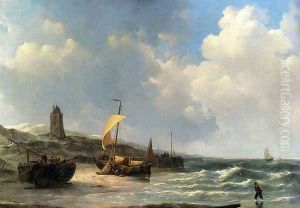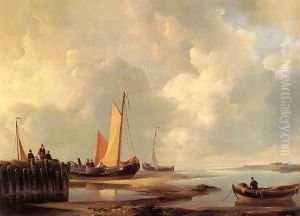Jan Christianus Schotel Paintings
Jan Christianus Schotel was a Dutch painter born on September 11, 1787, in Dordrecht, Netherlands. He is primarily known for his maritime paintings, capturing the essence of the Dutch seafaring spirit of the 19th century. Schotel's works are characterized by their detailed depiction of ships, the sea, and the interplay of light and shadow, showcasing both the tranquility and the tumult of sea life. His paintings often reflect the Dutch Golden Age tradition, echoing the styles of earlier masters while incorporating his unique perspective and technique.
Schotel's interest in maritime subjects was likely influenced by his upbringing in Dordrecht, a city with a rich maritime history and close proximity to the sea. He initially trained under his father, Johannes Schotel, who was a decorative painter. This early education grounded him in the fundamentals of painting, but it was his personal passion for the sea and ships that shaped the direction of his artistic career. Schotel further developed his skills and established his reputation through rigorous study and practice, eventually becoming one of the most respected maritime painters of his time.
Throughout his career, Jan Christianus Schotel participated in numerous exhibitions and gained recognition beyond his hometown. His works were appreciated for their meticulous attention to detail, composition, and ability to capture the mood of the maritime scenes he portrayed. Schotel's paintings appealed to a wide audience, including collectors and art enthusiasts in the Netherlands and abroad. Despite his success, Schotel remained deeply connected to his roots in Dordrecht, where he continued to live and work until his death on December 14, 1838.
Schotel's legacy lives on through his contributions to Dutch maritime painting. His works are preserved in various collections and museums, serving as a testament to his skill and dedication to capturing the essence of the sea. Jan Christianus Schotel's paintings not only depict maritime scenes with remarkable accuracy and beauty but also evoke the broader historical and cultural significance of the Netherlands' relationship with the sea during the 19th century.

